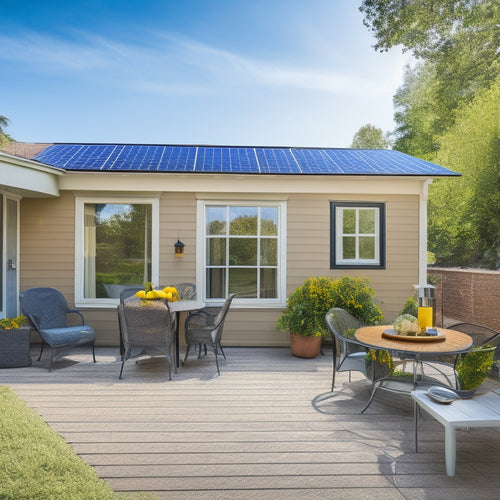
Why Do Solar Panel Mounting Systems Cost So Much?
Share
You're likely surprised to learn that the cost of a solar panel mounting system is driven by a complex array of factors, including the sourcing of high-quality raw materials, intricate engineering and design considerations, and meticulous compliance with industry regulations. It's not just about the materials used, but also the expertise required to guarantee structural integrity and meeting certifications like UL and NEC. Add to that the need for customized solutions to accommodate unique site characteristics, and you're looking at a significant investment. But as you explore the specifics, you'll discover how these components come together to justify the expense.
Key Takeaways
• Fluctuating global market trends and surge in demand drive up the cost of raw materials like aluminum and stainless steel.
• Complex design and engineering requirements, including load calculations and simulations, increase production costs.
• Installation and labor expenses are high due to the need for skilled technicians, specialized equipment, and permit fees.
• Compliance with certifications, such as UL and NEC, and local building permits add to the overall cost.
• The use of high-quality components and customization for unique site characteristics also contribute to the overall expense.
Materials and Manufacturing Costs
Your solar panel mounting system's materials and manufacturing costs are largely driven by the type and quality of components used, with aluminum and stainless steel being the most common materials used in racking and tracking systems. The cost of these materials can fluctuate wildly depending on global market trends and supply chain dynamics. For instance, a surge in demand for stainless steel in the construction industry can drive up prices for solar panel manufacturers.
Raw material sourcing is a critical component of the manufacturing process, and companies must navigate complex supply chains to secure high-quality materials at a reasonable cost. You see, it's not just about finding the cheapest option; it's about finding the best balance of quality, price, and reliability. A single misstep in the sourcing process can have a ripple effect throughout the entire production line.
Design and Engineering Complexity
As you explore the design and engineering of your solar panel mounting system, you'll encounter a complex web of factors that drive up costs, from the intricacies of structural analysis to the nuances of aerodynamic modeling.
It's not just about slapping some panels on a roof; ensuring structural integrity is essential. You need to contemplate load calculations, taking into account wind, snow, and seismic loads, to guarantee your system can withstand the elements.
This complexity translates to higher costs, as engineers and designers must invest time and expertise to create customized solutions. The stakes are high – a faulty design can lead to system failure, compromising the entire investment.
To mitigate these risks, designers must run extensive simulations, perform detailed analysis, and collaborate with experts from various fields. This meticulous process comes at a price, adding to the overall cost of your solar panel mounting system.
Installation and Labor Expenses
When you factor in the costs of installing your solar panel mounting system, labor expenses quickly add up. This is driven by the need for skilled technicians to navigate complex rooftop layouts and guarantee secure, watertight connections. These specialists don't come cheap, and their expertise comes at a premium.
Plus, you'll need to factor in the cost of equipment, like ladders and harnesses, to assure their safety while working at heights. And let's not forget permit fees – you'll need to secure permits from local authorities before work can begin, adding to the overall cost.
In some areas, Union requirements may also drive up labor costs, as contractors must adhere to specific guidelines and regulations. As you can see, installation and labor expenses are a significant contributor to the overall cost of your solar panel mounting system.
It's not just about slapping some panels on your roof; it's about doing it safely, efficiently, and to code. So, be prepared to shell out some serious cash for the privilege of going green.
Certifications and Compliance Fees
To guarantee your solar panel mounting system meets industry standards and local building codes, you'll need to secure various certifications, adding to the overall cost with fees for UL (Underwriters Laboratories) certification, NEC (National Electric Code) compliance, and other required permits. These regulatory hurdles can be a real headache, but they're essential to verify that your system is safe and efficient.
Here are some of the key certifications and compliance fees you'll need to take into account:
-
UL certification: This verifies that your mounting system meets strict safety standards, and can add hundreds of dollars to your overall cost.
-
NEC compliance: You'll need to adhere to the National Electric Code, which outlines minimum safety standards for electrical systems. This can involve additional inspections and permits, adding to your expenses.
-
Local building permits: Depending on your location, you may need to obtain permits from local authorities, which can add to your costs.
High-Quality Component Selection
Choosing high-quality components for your solar panel mounting system is essential, as subpar materials can compromise the entire system's performance and longevity, adding long-term costs that outweigh any initial savings. You wouldn't want to skimp on quality only to end up with a system that's more prone to failure or requires frequent repairs.
Premium materials, on the other hand, guarantee a durable and efficient system that will generate clean energy for years to come.
To guarantee the quality of your solar panel mounting system, manufacturers put their components through advanced testing. This includes simulating harsh environmental conditions, such as extreme temperatures, high winds, and heavy snow loads, to ensure the system can withstand the elements.
By investing in high-quality components that have undergone rigorous testing, you can have peace of mind knowing your system will perform efficiently and last longer. Remember, it's not about being cheap; it's about being smart.
Investing in quality upfront will save you money and hassle in the long run.
Customization and Adaptability Needs
Optimizing your solar panel mounting system's performance requires accommodating the unique characteristics of your rooftop or installation site. This can involve adapting to irregularly shaped roofs, obstructions, or specific structural requirements. You're not dealing with a one-size-fits-all situation here. Every rooftop is different, and your mounting system needs to be tailored to your site's specific needs.
To guarantee a secure and efficient installation, you'll need to conduct thorough site assessments to identify potential challenges. This might involve:
- Accounting for roof complexities like skylights, vents, or multiple levels
- Designing around obstructions like chimneys, HVAC units, or roof-mounted equipment
- Addressing local building codes and regulatory requirements
These customization and adaptability needs can drive up the cost of your solar panel mounting system. But trust us, it's worth it. A bespoke mounting system guarantees that your solar panels operate at peak performance, providing you with maximum energy output and a higher return on investment.
Warranty and Support Expenses
When you invest in a solar panel mounting system, you're not just paying for the hardware - you're also buying into a warranty and support package that can greatly impact your overall costs. Think of it as buying insurance for your investment; it's a safety net that protects you from unexpected expenses down the line.
Premium service and extended coverage come at a price, but they're essential for maintaining the performance and longevity of your solar panel system. Manufacturers know that a faulty mounting system can be catastrophic, so they offer warranties that cover parts and labor for a certain period. This guarantee gives you peace of mind, knowing that you're protected in case something goes wrong.
The cost of warranty and support expenses is factored into the overall price of the mounting system. It's a necessary evil, but one that's well worth it. After all, you wouldn't buy a car without knowing it's backed by a reliable warranty, would you?
The same principle applies here. By investing in a reputable manufacturer's warranty and support package, you're safeguarding your investment and ensuring a smooth, hassle-free experience.
Frequently Asked Questions
Can I Install Solar Panels on a Metal Roof?
You can install solar panels on a metal roof, but it's important to make sure waterproofing solutions are integrated into the mounting system to prevent leaks and corrosion, ensuring a safe and durable installation.
Do Solar Panels Work During a Power Outage?
"When the grid goes dark, you'll be glad you invested in a grid backup system with energy storage - it's like having a superhero sidekick that keeps your lights on during power outages!"
How Often Should I Clean My Solar Panels?
You should clean your solar panels every 6-12 months, as dust accumulation can reduce panel efficiency by up to 25%. Don't let dirt dim your solar savings – grab a soft brush and get cleaning to maximize your renewable returns!
Can I Move Solar Panels to a New Location?
If you're planning to move your solar panels to a new location, consider investing in portable racking systems that allow for temporary installations, making it easier for you to pack up and relocate your panels without hassle.
Are Solar Panels Recyclable at the End of Life?
You're wondering if solar panels are recyclable at the end of life? Yes, they are! You can opt for Panel Refurb or Material Reuse, reducing waste and costs, and giving old panels a new lease on life - a win-win for the planet and your wallet!
Related Posts
-

10 Tips to Buy Affordable Solar Panels Online
When purchasing affordable solar panels online, you'll want to research reputable retailers, compare prices, and chec...
-

What You Need to Know About Permits and Inspections
You need to navigate the complex landscape of permits and inspections to guarantee your project complies with local z...
-

Charging Station Incentives: Why So Many Are Free
You're likely to stumble upon free or low-cost charging stations due to a convergence of incentives. Government rebat...


